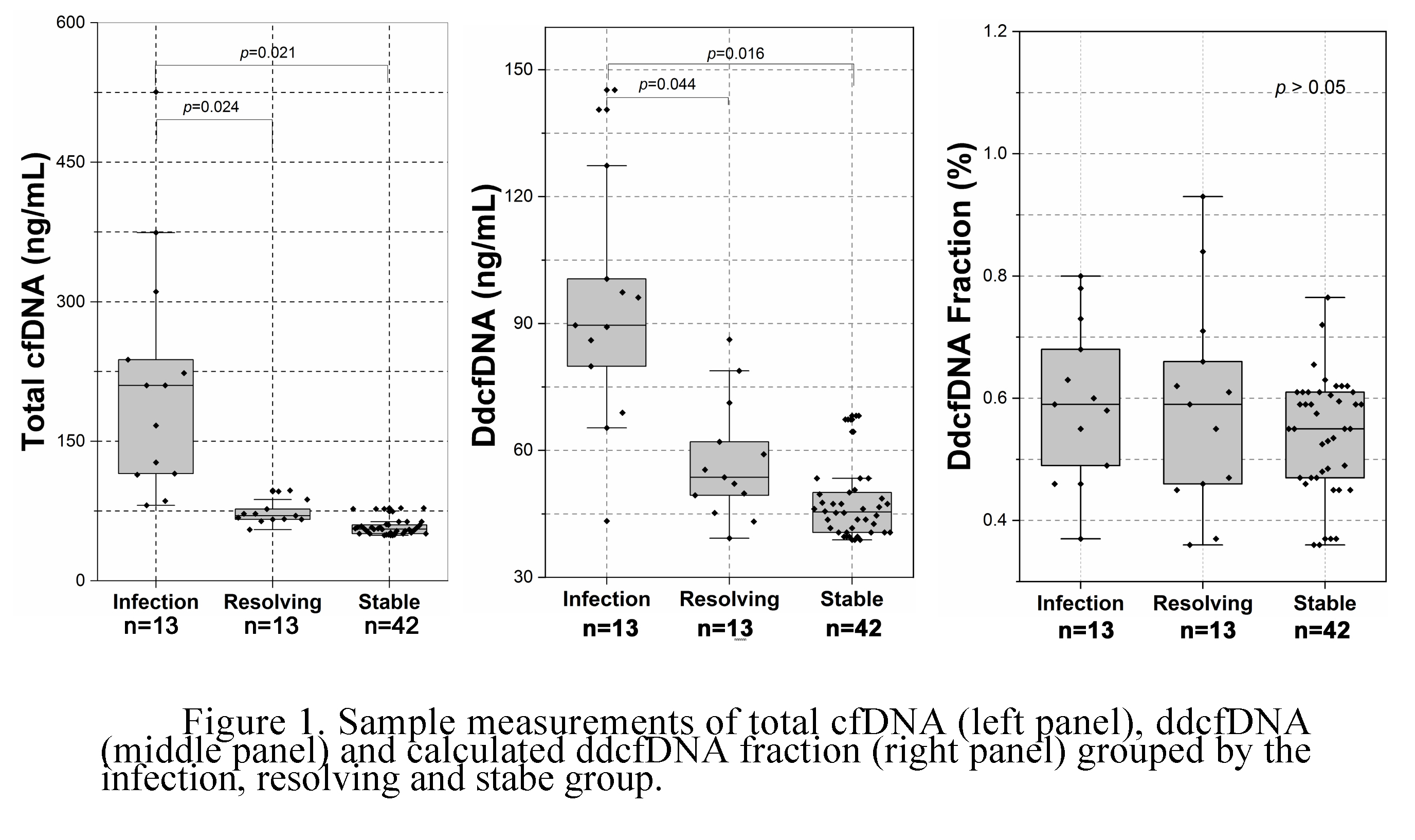The level of plasm donor-derived cell-free DNA in kidney transplant patients with severe pneumonia
Feng Liu2, Liu Lei1, Liu Haitao2, Shu Liping2, Peng Longkai1.
1Xiangyang Hospital No. 2 of Central South University, Xiangyang Hospital No. 2 of Central South University, Changsha, People's Republic of China; 2Market Department, AlloDx, Shanghai, People's Republic of China
Background: Pulmonary infection is one of the common complications after kidney transplantation. Donor-derived cell-free DNA (ddcfDNA) is a new biomarker to diagnose allograft injury. Currently, it is unclear how ddcfDNA levels change in kidney transplant patients with severe pneumonia
Methods: Diagnosis of pathogenic microorganism by pathogen culture, immunofluorescence assay and qPCR assay. 13 kidney transplant patients were diagnosed with pneumonia (IDSA/ATS criteria) have been recruited, and paired plasm samples were collected on the 1st day of diagnosis (infection subgroup) and on the 7th day after treatment (resolving subgroup). Meanwhile, 42 kidney transplant patients at stable phase were selected as the stable group. Total cfDNA was extract from plasm and quantification by Qubit 3.0), ddcfDNA(%) quantification through target region capture sequencing and calculated by maximum likehood estimation (MLE). Set absolute quantification of ddcfDNA as copies per mL plasma (cp/mL) is calculated by multiplying the total concentration of cfDNA(cp/mL) by the ddcfDNA fraction (%).
Results: The total of 22 pathogens were detected, including 16 bacterial (i.e. PAE, ABA, KPN), 4 viral (i.e. CMV, EB), 2 fungal (i.e. Aspergillus, PCP). And detect negative on the 7th day of treatment. The mean of total cfDNA concentration in infection, resolving and stable subgroup was 222±78.9 ng/mL, 77±34.5ng/mL, 60±24.4ng/mL, respectively. Significant differences between infection group and resolving subgroup(p=0.024)/stable subgroup(p=0.021) was found, but no significant difference between resolving subgroup and stable subgroup (p>0.05). For fraction of ddcfDNA (%) analysis, the mean ddcfDNA(%) of infection, resolving and stable subgroup was 0.58%±0.12%, 0.58%±0.16%, 0.54%±0.08%, respectively. there were no significant differences among three subgroup (p>0.05). For absolute ddcfDNA quantification, the mean ddcfDNA(cp/mL) in infection, resolving and stable subgroup was 94.6±29.26cp/mL, 56.41±13.43cp/mL, 49.81±10.09cp/mL, respectively. Significant differences in the distribution of ddcfDNA were found between infection subgroup and resolving subgroup (p=0.044)/stable subgroup (p=0.016), but no significant difference between the resolving and stable subgroup (p=0.423). (Figure 1).
Conclusions: Severe pneumonia can cause kidney injury, and increase in absolute amount of ddcfDNA in plasm, but no fraction of ddcfDNA. Due to the increase of recipient cfDNA from activated lymphocytes with a higher apoptotic rate caused by infection, that fraction of ddcfDNA in plasma was diluted, suggesting that when using ddcfDNA fraction to detect rejection, severe pneumonia does not affect the detection specificity of ddcfDNA.

There are no comments yet...